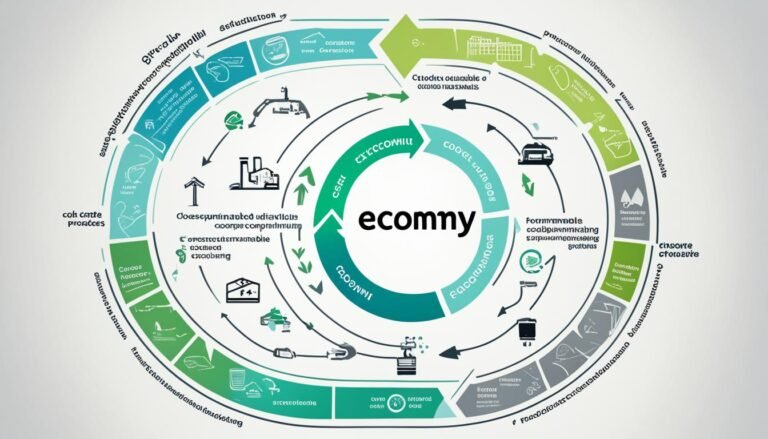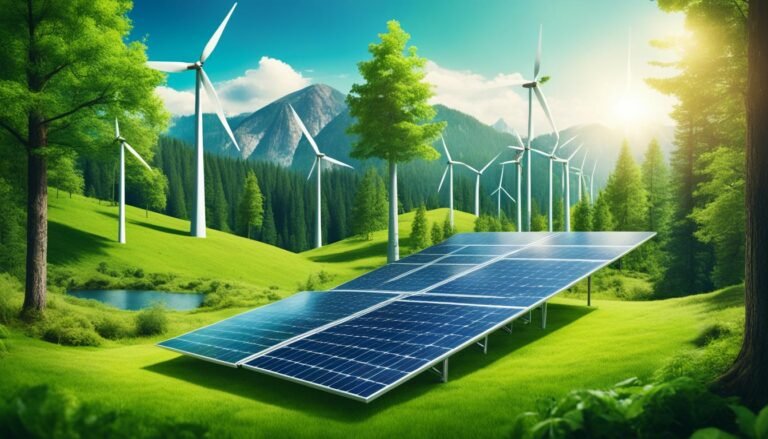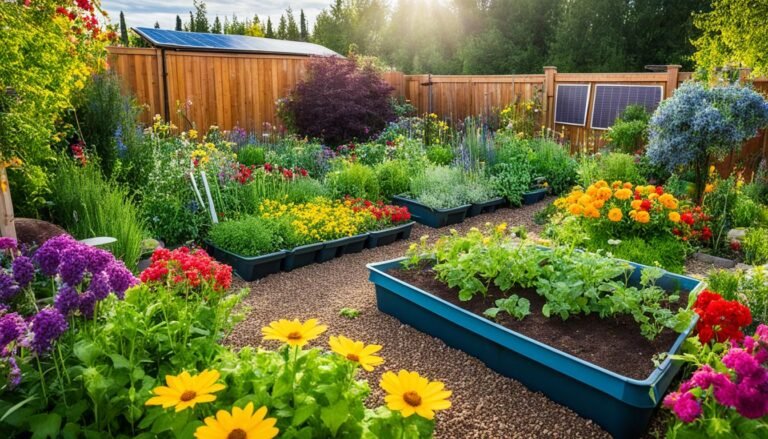Powering a Greener Future: Exploring Renewable Energy Options for Your Home
In today’s world, the drive for green living is strong. Exploring renewable energy for your house is more important than ever. This is because over 75% of bad gases come from burning fossil fuels like coal and oil.
By using solar panels, wind turbines, and other green tech, we can cut down on harmful gases. And here’s a plus: these methods save money too. Almost a third of world electricity comes from renewable sources now. This number could jump to two thirds by 2030.
Shifting to green power also means more jobs. Investing in renewables makes three times as many jobs as sticking with fossil fuels. It’s clear that greener homes aren’t just better for the planet—they’re smarter for our wallets and job markets too.
Ready to start your green journey? It all begins with checking how you use energy at home. Then, you can pick the right renewable options. Solar power has gotten 85% cheaper over the last decade.
Plus, the government helps with the cost at first. This help, along with rising property values and independence from big energy companies, makes green homes a great choice. By aiming for zero emissions by 2030, we could see 14 million new jobs in clean energy.
Key Takeaways
- Fossil fuels account for over 75% of global greenhouse gas emissions.
- Renewable energy currently generates about 29% of the world’s electricity.
- Electricity from solar power became 85% cheaper between 2010 and 2020.
- Investing in renewables creates three times more jobs than fossil fuels.
- Transitioning to renewable energy can save up to $4.2 trillion per year by 2030.
- Government incentives can offset the initial costs of renewable installations.
Introduction to Renewable Energy
Renewable energy helps in our fight against climate change. It uses clean, sustainable sources to cut down on greenhouse gases. These gases are a big part of why our planet is getting warmer. Using green technology is a key step towards meeting global environmental goals.
Many homeowners are looking into green energy options. This includes solar and wind systems, as well as microhydropower and hybrid systems. These are good for the environment and also lower the amount of energy from harmful sources we use.
To pick the right energy system, we need to understand our electricity needs. This means looking at costs, energy usage throughout the day and year, and ways to save energy. We have to remember that local rules and building codes might affect what systems we can use.
For systems connected to the grid, some extra equipment is needed to meet safety standards. On the other hand, systems that work alone in remote areas need different parts. These include batteries and special control units for the power.
Here are some small renewable energy choices:
- Solar electric systems: Work well in places without power lines.
- Wind electric systems: Flexible and good for things like pumping water.
- Microhydropower systems: Can produce a lot of electricity, great for homes or farms.
- Hybrid electric systems: Mix solar and wind for constant power all year.
A report by the International Energy Agency suggests renewables and nuclear energy will lead in power growth by 2025. Also, thanks to the U.S. Inflation Reduction Act of 2022, over 100,000 new clean energy jobs were made in just six months.
In 2021, the International Renewable Energy Agency found about 923,400 clean energy jobs in the U.S. It says the world’s clean energy jobs could reach 38 million by 2030. As more people join the renewable energy sector, this helps the planet and its workers.
Why Switch to Renewable Energy?
There are many good reasons to switch to renewable energy. It helps the environment and your wallet. You get energy independence and your home’s value goes up. Plus, there are government incentives to support your choice.
Environmental Impact
Switching to renewable energy cuts down on the carbon footprint. That’s good news for the planet. Currently, almost a third of the world’s heating gases come from making electricity.
Renewable sources like wind and solar power are much cleaner. For example, wind energy is way less polluting than gas and coal. It’s proven that if we step up our use of renewable energy, we can greatly reduce harmful emissions.
Economic Benefits
Going renewable also saves money. Installing solar has become much cheaper over the years. Wind energy is also a cost-effective choice.
Renewable energy use can keep energy prices stable. It also lessens the need for costly fossil fuels. That means energy bills can be more predictable and affordable.
Energy Independence
Renewable energy makes you less reliant on others for power. Homeowners can produce their own electricity. Solar homes can store energy for later use.
Many places let you sell extra energy back to the grid. This setup offers more reliability and independence during power outages.
Increased Home Value
Renewable energy systems boost your home’s worth. Solar panels are a prime example. They save money and make your house more efficient.
Green homes are in demand. So, houses with renewable setups sell better and faster. It’s a win-win for both you and the planet.
Government Incentives
There are many government perks for choosing renewable energy. Things like rebates and tax breaks help with the initial cost. This support makes it more affordable for many people.
Solar Energy: Harnessing the Power of the Sun
Solar energy is becoming more popular because it’s both green and cost-effective. It helps reduce our carbon footprint. This section looks at how solar panels work, from capturing sunlight to their installation and upkeep.
How Solar Panels Work
Solar panels turn sunlight into energy with their photovoltaic cells. They do best on roofs that face south, west, or east for the most sun. A 300-watt solar panel can give 0.3 kWh every hour when the sun is shining.
To make 1,000 kWh each month, you’d need about 30 solar panels. Over time, solar panels have gotten more efficient. Now, you can get the same power with fewer panels.
Installation and Maintenance
When setting up solar panels, knowing your yearly energy use helps. The panels need to be placed just right on your roof. Keeping them clean and checking them often is key to their long-term success.
There are often tax breaks and other savings from the government. These can cut your costs. Also, some contractors offer payment plans to help with the sticker shock.
Cost and Savings
It can be a big up-front cost to go solar. But, the savings over time are worth it. There are many ways to save, from government help to how you pay for your panels.
Adding solar can make your home sell for more and quicker. This is because many buyers want eco-friendly houses. Plus, you’re ready if the power goes out. So, going solar is good for both your wallet and the planet.
Harnessing Wind Power for Your Home
Wind turbines are the graceful giants of the renewable energy world. They show us how we’re moving to cleaner energy. And they highlight big leaps in wind power technology. Wind energy has grown a lot, becoming a key player in our move to sustainable energy.
A 1.5-kilowatt wind turbine could power a home that uses 300KwH a month. This is if it gets an average wind of 14mph yearly. But, an average American home needs much more energy, about 10,932 kilowatt-hours yearly. For such a home, you’d need a 10-kilowatt wind turbine. It could cost from $50,000 to $80,000 or more. Remember, it might take a long time to save enough money to cover this cost.
Even though wind energy setups can be expensive, their benefits are huge. For example, Inspire Clean Energy has saved a lot of greenhouse gases. And wind farms have helped save money on respiratory medications, cutting $9.4 billion in spending in 2018.
Wind turbines may not always produce power. On average, they are efficient 40% of the time. But they can turn 60% to 90% of the wind they catch into electricity. This is better than solar panels, which usually convert only 17% to 19% of sunlight into power.
Economically, wind energy provides numerous benefits:
- Wind projects give local communities about $2 billion yearly thanks to taxes and land agreements.
- The U.S. wind industry employs over 125,000 people, and more jobs are expected in the future.
- Wind energy agreements that lock in prices for 20 years could save up to $280 billion by 2050.
Also, government incentives make installing wind turbines more affordable. Things like the Investment Tax Credit (ITC) and Bonus Depreciation help a lot. After these incentives, the cost of wind energy can be similar to or better than solar. For example, a 10 kW wind turbine might cost about $14,700 after incentives.
In short, wind power needs a big initial investment. But in the long run, it offers many benefits. Wind turbines help us use less fossil fuels. They are good for the economy and the environment. They are crucial for moving to renewable energy.
Geothermal Energy: Heating and Cooling from Below
Geothermal energy is a great way to keep your home comfortable. It uses the earth’s natural temperature. This method uses pumps to move heat between your home and the ground. It keeps your home at a good temperature all year round.
How Geothermal Systems Work
Geothermal systems have a main unit called a heat pump. It moves heat from your home to the ground and back. They use a closed-loop system with water. This system is efficient, easy to care for, and works well in houses. The heat pumps take advantage of the earth’s reliable temperatures. They make sure your house stays cool in summer and warm in winter.
Installation and Maintenance
The cost to install a geothermal system can be high at first. But, it saves you money in the long run. Since they last a long time and are cheap to keep up, many people find them worth the cost. A few things that affect the installation price are the size of the system, where you live, and how hard the setup is. Summers PHC and similar companies make the process easier by being clear about the costs and offering good payment plans.
Installing these systems needs skilled workers because it’s tricky to set up the underground pipes. But once everything is in place, these systems don’t need much work. A few regular checks and adding more antifreeze from time to time help keep things running smoothly. People who use geothermal energy spend less money on running their homes. They also help the planet by cutting the pollution their homes make.
To sum it up, geothermal energy is a green and smart way to heat and cool your house. Putting in a geothermal system is a clever choice. It lets you use clean energy. Plus, it saves you money over a long time. You’ll also be cozier in your home.
Hydroelectric Power: Utilizing Water Flow
Hydroelectric power is a key player in the world of renewable energy. It works with the flow of water to generate electricity, making it a model for sustainable power production. Big hydroelectric dams are central to this process, capturing the energy of moving water.
Currently, hydropower provides about 71% of the world’s renewable electricity. This shows how vital and dependable hydroelectricity is when compared to other green energy forms. Modern water-powered turbines convert over 90% of the water’s energy into electricity. This beats the efficiency of solar panels and wind turbines by a lot.
China leads the way in producing hydroelectricity, mainly due to the Three Gorges Dam. This massive dam can generate 22,500 megawatts of power, making it the biggest globally. The United States, Brazil, Canada, India, and Russia are also key players in hydropower.
There are, however, some downsides to hydroelectric dams. Building a hydropower plant requires a big initial investment. The planning and design phase can cause delays, which makes the project take a long time to complete. Despite the upfront costs, once a dam is up and running, it has relatively low maintenance costs and can produce electricity for many years.
One big benefit of hydropower is that it can store water for when it’s needed most. This helps keep a steady supply of power, even when there’s little rain. But, these big projects can hurt local fish and their habitats. There’s also a concern about dams breaking and the air pollution that comes from their water storage areas.
Even with challenges, hydroelectric power is essential for a transition to green energy. It shows that sustainable power production is a significant part of our quest for a greener future.
Biomass Energy: Converting Organic Material into Power
Biomass energy is a smart way to make power from organic stuff. It uses the energy in things like plants and animal waste. Then, it turns it into power through biomass conversion.
What is Biomass Energy?
It comes from organic sources like plants, wood, and farm waste. Energy is made via burning, turning into gas, or heating these materials. This creates electricity, warmth, or biofuels. In 2022, it was about 5% of all U.S. energy use, a number that’s growing.
In places like Asia and Europe, gasification plants turn a lot of trash into power. For instance, one plant in England powers 50,000 homes with 350,000 tons of trash yearly.
Residential Applications
For people at home, biomass energy is green and practical. You can have stoves, boilers, or CHP systems that burn wood or other organic material. These cut down on oil use and recycle waste.
They help balance the carbon cycle by breaking down waste. This means a greener world. Plus, it’s getting more popular because it’s cheaper. Using biomass is good for the environment and saves money long-term.
One day, residential systems might make 40 million tons of hydrogen each year. This could be a game changer, turning trash into energy at home.
Maximizing Energy Efficiency in Your Home
Maximizing energy efficiency at home is key to lower energy use and bills. Start with a full home energy audit. Then, use what you find to make your home more efficient and valuable.
Conducting an Energy Audit
Begin with a home energy audit to find where you can save. The Home Energy Score by the U.S. Department of Energy tells you how well your home uses energy. It also gives tips on what to improve and how much you can save. This helps you focus on what needs fixing first.
- Identify air leaks and seal them with caulking and weather stripping.
- Inspect insulation levels and upgrade where necessary to minimize heat loss.
- Assess the efficiency of heating and cooling systems; consider a more energy-efficient system if needed.
- Examine the effectiveness of windows and doors; install energy-efficient models if required.
Implementing Energy-Saving Measures
Once you know where your home can improve, it’s time to take action. Here are some top strategies:
- Upgrade to smart thermostats: They let you control your home’s temperature from anywhere. Plus, they learn your schedule to save energy.
- Install cool roofs: These roofs stay cooler by reflecting sunlight. They reduce how much you need to run your AC.
- Adopt passive solar home design: Design your home to take in or keep out the sun naturally, using the climate and location.
- Consider renewable energy systems: Options like solar power can help you use less non-renewable energy.
- Practice regular maintenance: Keeping up with your heating and cooling systems makes them more efficient and last longer.
By doing a detailed energy audit and following through with fixes, your home will be more energy-efficient. You’ll not only save money but also help the planet. This fits into global efforts for a more sustainable future.
Powering a Greener Future: Exploring Renewable Energy Options for Your Home
Choosing renewable energy is a big step towards a green future. Homeowners have many options for making their homes more eco-friendly. They can use solar power, wind turbines, or geothermal systems. These choices help the planet and bring many benefits.
Turning to renewable energy cuts down carbon footprints. Studies show a significant percentage reduction in pollution. Investing in green energy saves money over time. Homes save a lot on energy bills thanks to government help and incentives. These homes are also worth more.
Experts help make renewable energy work in your home. They install and keep your systems running well. Maintaining green energy systems is easy, unlike traditional ones that need a lot of work.
Green energy is good for the earth. It doesn’t add much pollution, so it fights climate change. Renewable sources, like solar and wind power, use nature efficiently.
Green energy adoption means having your own power. It makes your home greener and stronger during tough times. Plus, green energy is becoming very cost-effective, thanks to new technology.
Today, it’s cheaper to get started with green energy. Governments and companies offer help with costs. This support shows a commitment to the planet’s future. By joining in, homeowners help the environment globally.
“Energy-efficient buildings, such as those found in zero-energy communities, play a pivotal role in reducing utility bills and supporting a sustainable lifestyle,” experts explain.
Choosing green energy brings many good things. Besides saving money, it helps the earth a lot. With everyone’s effort, we can enjoy living sustainably in the future.
Conclusion
Using renewable energy at home makes us part of a big change. It’s good for the planet and our lives too. Solar power is a great choice, especially in places like Colorado. It can turn 22% of sunlight into electricity. And it might produce 24.7 million megawatt hours every year. Wind power is growing fast too. It could meet 20% of the world’s electricity needs by 2030. This all shows how important these energy sources are.
Water power has been a source of energy for a long time. It uses moving water to make electricity. It’s quite good because it creates power without making the air dirty. But, setting up these water systems can harm the local nature. Geothermal energy is also very reliable. It doesn’t depend on the weather. By using the Earth’s heat, it can keep making power. Geothermal power is good for the planet and the economy.
Biomass energy is another key part of renewable power. It uses natural materials to make energy. Homeowners who go for these renewable choices help a lot. They are part of the 72% of new power that comes from clean sources. This means good things for your finances and the environment. Choosing renewable energy is a smart and caring move for the future.
Source Links
- Renewable energy – powering a safer future | United Nations
- 100% Renewable Energy Plan for Residential Buildings – OCPA
- Harnessing the Power of Solar Energy for a Greener Future – Green Choice Energy
- Planning for Home Renewable Energy Systems
- Powering the future: explore the rise of clean energy jobs
- Renewable Energy – Lesson
- Benefits of Renewable Energy Use
- Renewable Energy: The Clean Facts
- Future of Renewable Energy: The Importance of Renewable Energy in the Future | Inspire | Inspire Clean Energy
- Harnessing the Power of the Sun: An Introduction to Solar Energy
- Sizing Your Solar System for a Greener Future – Constant Energy
- Unleashing the Power of the Sun: A Guide to Solar Energy for Your Home
- Home Wind Turbines: Wind Power for Homes Explained | Inspire Clean Energy
- Wind Turbines vs. Solar Panels: The Renewable Energy Landscape
- Breadcrumbs
- Geothermal Heating and Cooling Cost: A Comprehensive Guide by Summers PHC
- Geothermal Basics
- Geothermal FAQs
- Hydroelectric Energy
- The Pros and Cons of Hydropower | TRADESAFE
- Benefits of Hydropower
- Biomass Energy
- Best Renewable Energy Sources for Homes | Inspire Clean Energy | Inspire Clean Energy
- Biomass explained – U.S. Energy Information Administration (EIA)
- Efficient Home Design
- Maximizing Energy Efficiency: Home Heating and Cooling Solutions
- Why Energy Efficient Homes Matter
- Embracing a Greener Future: Switching Your Home to Renewable Energy
- Powering Your Home Responsibly: Exploring Green Energy and Prepaid Electricity
- Building a Greener Future: Exploring Zero Energy Communities
- Renewable Energy Sources: Powering a Greener Future
- All About Solar Energy – Colorado Clean Energy Fund
- Powering A Sustainable Future: Exploring Renewable Energy Technologies








